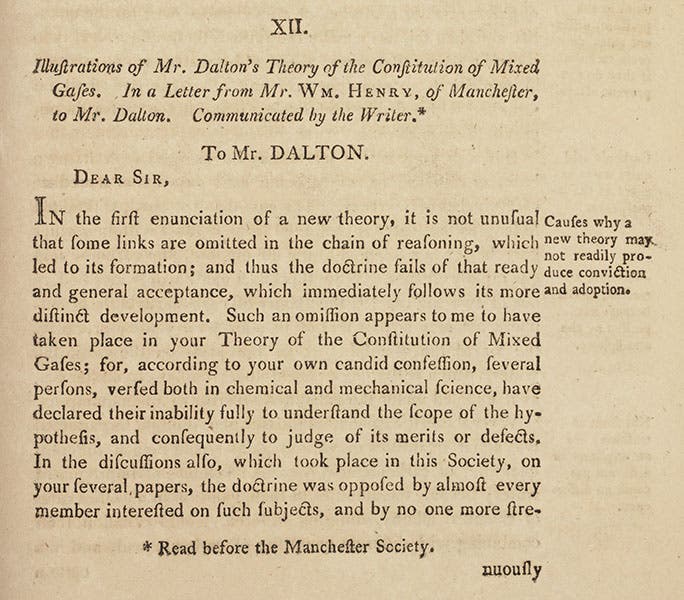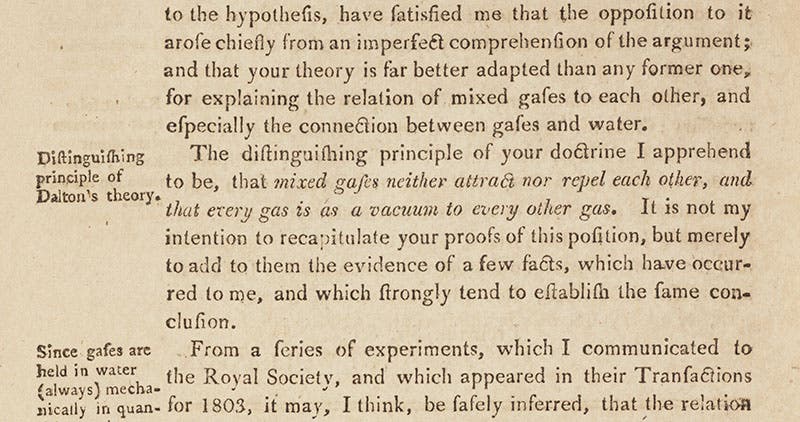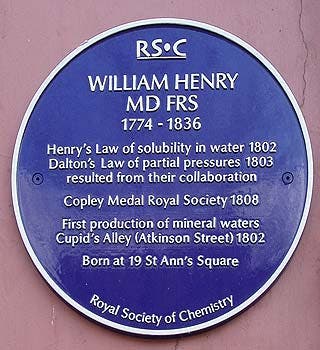Scientist of the Day - William Henry
William Henry, an English chemist, was born Dec. 12, 1774. Henry grew up in Manchester during the heady days of the Chemical Revolution, when it was discovered that air and water are not elements, but mixtures or compounds of newly discovered gases, such as nitrogen, hydrogen, and oxygen. One of Henry’s close friends was a fellow Mancunian, John Dalton, who by 1801 had yet to propose his atomic theory, but who had discovered that in a mixture of gases, say carbon dioxide, oxygen, and nitrogen, the total pressure exerted by the mixture is the sum of the pressures each gas would exert if each alone occupied the total volume of the mixture. This is called Dalton's law of partial pressures.
The next year, 1802, Henry discovered his own law, that the amount of a gas that goes into solution in a liquid is directly proportional to the partial pressure of that gas above the liquid. Although properly called Henry's law, one could just as well call it Coke's law, since it explains what happens when you open a can of soda. When the can is sealed, CO2 stays dissolved in the soft drink, held there by the pressure of CO2 at the top of the can. When you pop the top, the pressure drops, and most of the CO2 comes out of solution, forming the familiar bubbles of carbonated beverages. All of this seems pretty reasonable, but it is odd to be told that if you were to fill the top of a can of soda with nitrogen, rather than CO2, the dissolved CO2 would immediately come out of solution, even in the sealed can, because to its one-track mind, if there is no CO2 at the top of the can, there is no gas there at all. I am sure this makes perfect sense to a physical chemist, but to the rest of us, it seems like Nature is being slightly contrary here.
Henry published his law in 1803 in the Philosophical Transactions of the Royal Society of London, and then published a follow-up article the next year in the Journal of Natural Philosophy, Chemistry and the Arts, commonly known as Nicholson’s Journal. The second paper is notable because it is there that Henry pens his most quotable one-liner: Every gas is as a vacuum to every other gas. That sums up the mystery of partial pressure about as well as anything. We have both of these articles in the Serials collection of the Library; we show here the first page of the 1804 paper (second image), and a detail of Henry’s famous pronouncement about partial pressure (third image).
We have several times in these notices mentioned an engraving of 1862 that grouped together in an artificial portrait all of the "Distinguished Men of Science" that one could have found in England in 1807/08, including the likes of Matthew Boulton, William Herschel and James Watt. Henry was alive in 1807 and distinguished enough to find a place in the portrait. We show here just a detail of the engraving (first image); Henry is the central standing figure with black, unruly hair. The gentleman seated at the table with eye-glasses and a raised finger is John Dalton. Unimpressed by the prestigious gathering is Henry Cavendish, discoverer of hydrogen, asleep in the armchair. We did not reproduce this image when we featured Cavendish, not wanting to tarnish his birthday. You can see the complete engraving here.
There is a Blue Plaque honoring Henry that is affixed to a wall near his birthplace in St. Ann's Square, Manchester.
Dr. William B. Ashworth, Jr., Consultant for the History of Science, Linda Hall Library and Associate Professor, Department of History, University of Missouri-Kansas City. Comments or corrections are welcome; please direct to ashworthw@umkc.edu.









